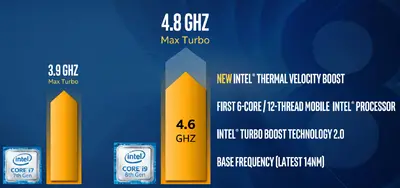| Line 4: | Line 4: | ||
== Overview == | == Overview == | ||
[[File:intel turbo velocity boost.png|right|400px]] | [[File:intel turbo velocity boost.png|right|400px]] | ||
| − | For devices with premium cooling solutions, microprocessors with {{intel|Turbo Boost}} support and TVB support enabled, the processor can automatically increase the clock frequency by up to an additional | + | For devices with premium cooling solutions, microprocessors with {{intel|Turbo Boost}} support and TVB support enabled, the processor can automatically increase the clock frequency by up to an additional few bins if T<sub>CASE</sub> is at a certain temperature or lower and turbo power budget is available. Though unlikely to be sustainable and will drop once the temperature threshold is exceeded, for highly bursty workloads (such as what impacts the user experience the most), the performance increase can be fairly significant. |
| + | |||
| + | === Up bins === | ||
| + | The exact number of bins and temperature depends on the processor (mobile, desktop, 45 W, 65 W): | ||
| + | |||
| + | * For {{intel|Coffee Lake H|l=core}}, TVB is +200 MHz if T<sub>CASE</sub> is at 50°C or lower and turbo power budget is available. | ||
| + | * For {{intel|Coffee Lake R|l=core}}, TVB is +100 MHz if T<sub>CASE</sub> is at 70°C or lower and turbo power budget is available. | ||
== History == | == History == | ||
| − | TVB was introduced with {{intel|Coffee Lake H|l=core}} parts. | + | * TVB was introduced with {{intel|Coffee Lake H|l=core}} mobile parts. |
| + | * TVB was added to some desktop parts for the first in {{intel|Coffee Lake R|l=core}}. | ||
== See also == | == See also == | ||
Revision as of 10:13, 23 April 2019
Thermal Velocity Boost (TVB) is a microprocessor technology developed by Intel that attempts to enable temporary higher performance on top of Turbo Boost Technology by opportunistically and automatically increasing the processor's clock frequency.
Contents
Overview
For devices with premium cooling solutions, microprocessors with Turbo Boost support and TVB support enabled, the processor can automatically increase the clock frequency by up to an additional few bins if TCASE is at a certain temperature or lower and turbo power budget is available. Though unlikely to be sustainable and will drop once the temperature threshold is exceeded, for highly bursty workloads (such as what impacts the user experience the most), the performance increase can be fairly significant.
Up bins
The exact number of bins and temperature depends on the processor (mobile, desktop, 45 W, 65 W):
- For Coffee Lake H, TVB is +200 MHz if TCASE is at 50°C or lower and turbo power budget is available.
- For Coffee Lake R, TVB is +100 MHz if TCASE is at 70°C or lower and turbo power budget is available.
History
- TVB was introduced with Coffee Lake H mobile parts.
- TVB was added to some desktop parts for the first in Coffee Lake R.
See also
- Frequency behavior of Intel processors
